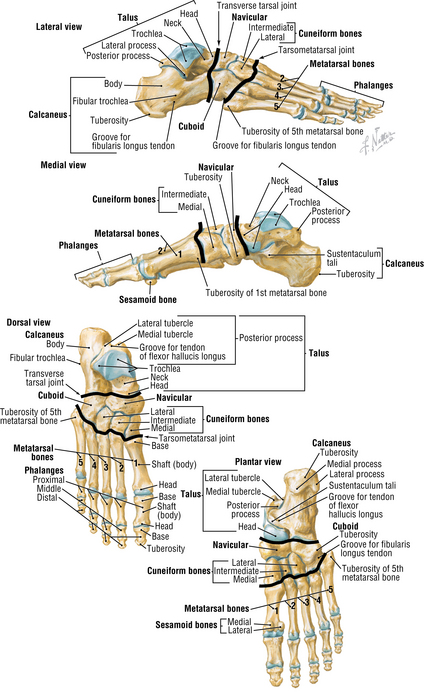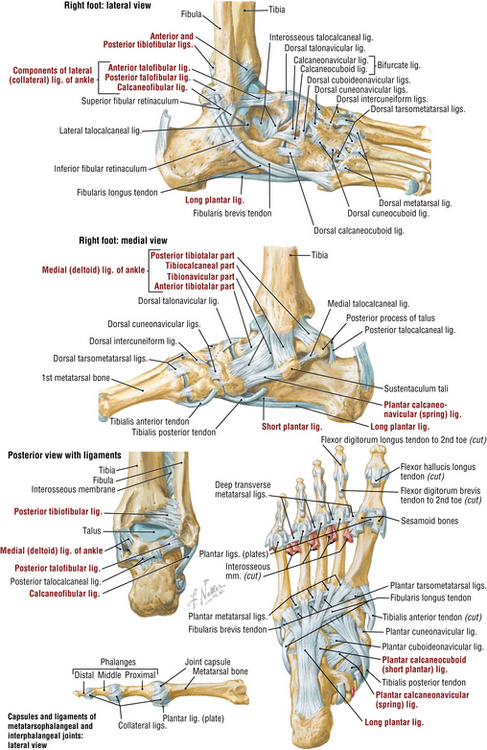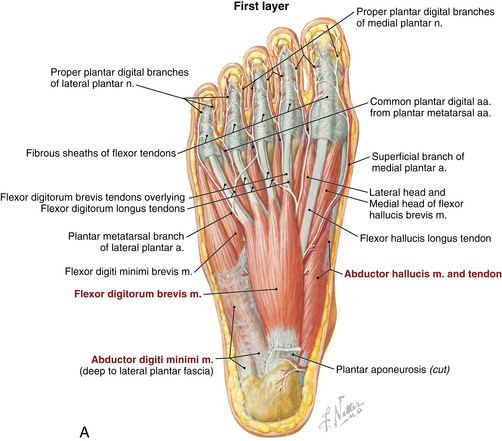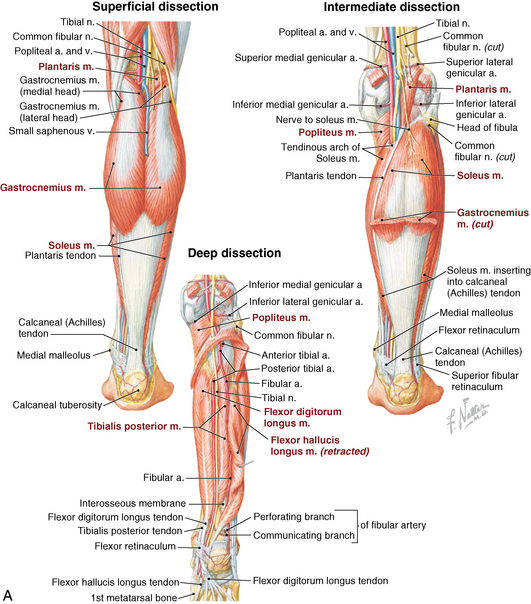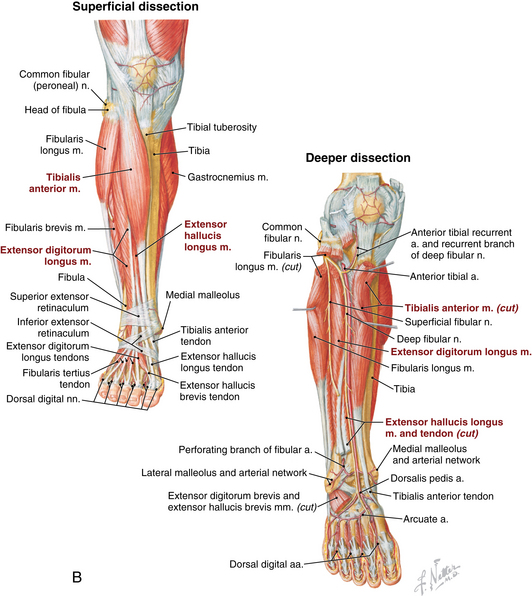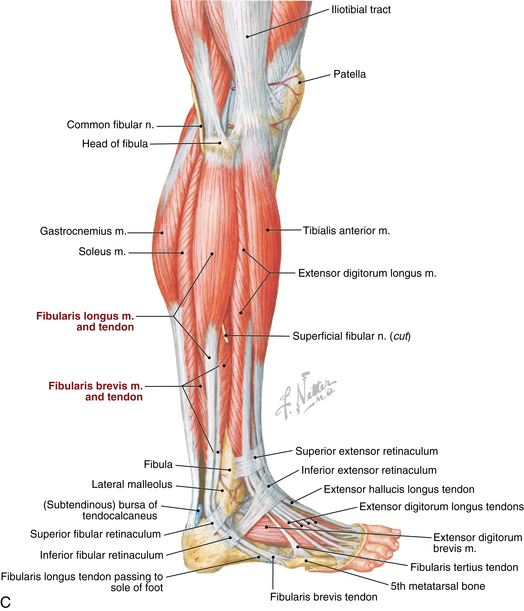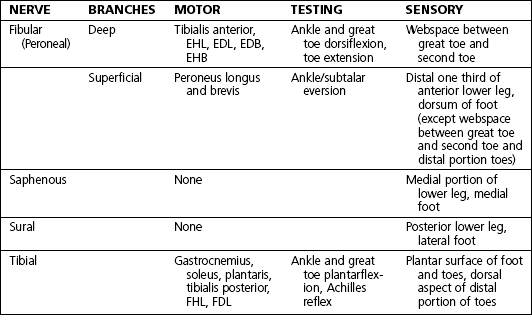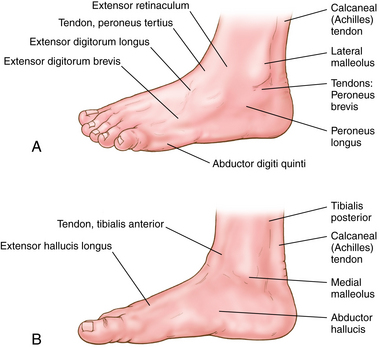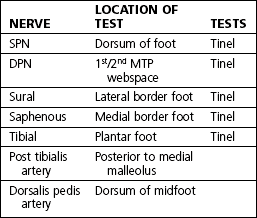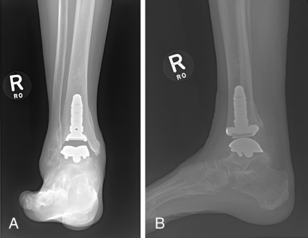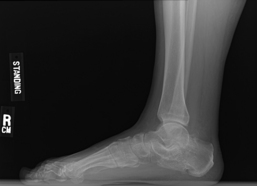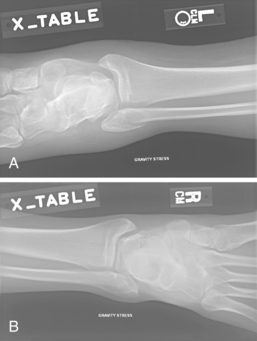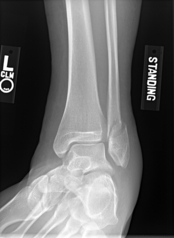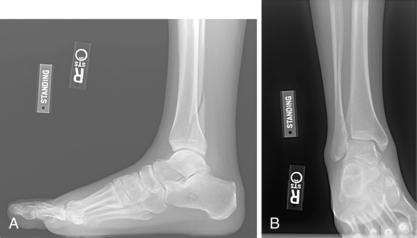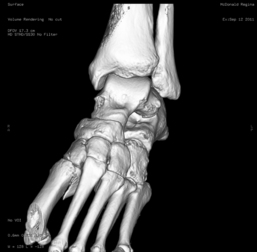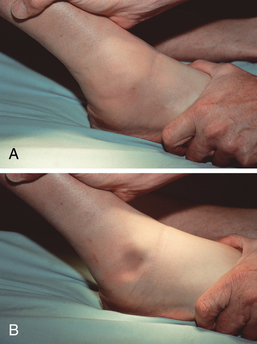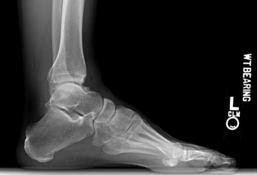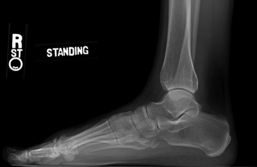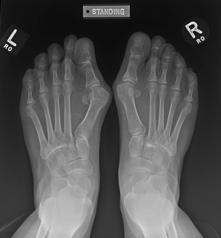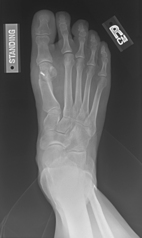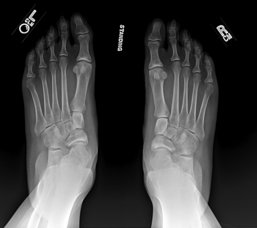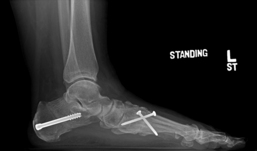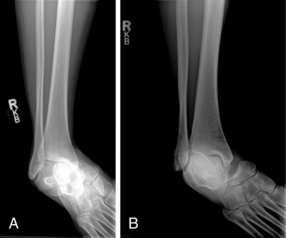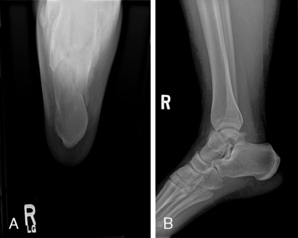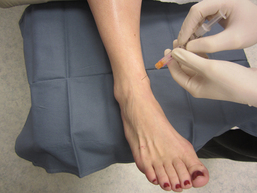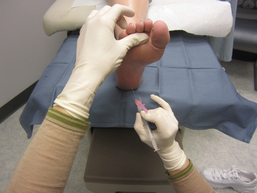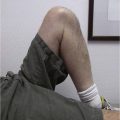Foot and ankle
Anatomy
Muscles, nerves, arteries: Figures 8-3, 8-4AB, and 8-5A-C
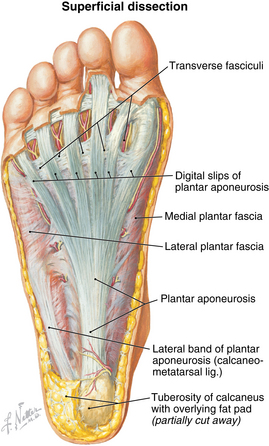
Figure 8-3. Dorsal view of the foot sole. (From Netter illustration from www.netterimages.com. Copyright Elsevier Inc. All rights reserved.)
Physical examination
 Inspect for edema, erythema, ecchymosis, deformity, callus formation, ulceration, and hairlessness. On standing examination, note hindfoot alignment. Assess gait pattern.
Inspect for edema, erythema, ecchymosis, deformity, callus formation, ulceration, and hairlessness. On standing examination, note hindfoot alignment. Assess gait pattern.
Normal range of motion: Table 8-2
Table 8-2.
Normal Ankle/Foot Range of Motion
| Ankle dorsiflexion | 10-23 degrees |
| Ankle plantarflexion | 23-48 degrees |
| Inversion | 5-35 degrees |
| Eversion | 5-25 degrees |
| First metatarsophalangeal dorsiflexion | 45-90 degrees |
| First metatarsophalangeal plantarflexion | 10-40 degrees |
Differential diagnosis: Table 8-4
Table 8-4.
| Anterior ankle pain | Ankle arthritis, osteochondral dessicans talus |
| Medial ankle pain | Posterior tibial tendinopathy, medial malleolar injury |
| Lateral ankle pain | Peroneal tendinopathy, ankle sprain |
| Posterior ankle pain | Achilles tendinopathy or rupture, os trigonum, posterior impingement |
| Midfoot | Lisfranc injury, midfoot arthritis |
| Forefoot | Metatarsal fracture, stress fracture, metatarsalgia |
| Heel pain | Plantar fasciitis, calcaneal stress fracture, insertional Achilles tendinopathy |
| Great toe | Hallux rigidus, hallux valgus |
| Lesser toes | Toe fracture, hammertoe deformity, Morton neuroma |
Ankle arthritis
 Αnkle arthritis may affect tibiotalar or subtalar joints.
Αnkle arthritis may affect tibiotalar or subtalar joints.
 Usually the patient has unilateral ankle pain, stiffness, swelling, ± history of injury. Pain worsens with weight-bearing activity.
Usually the patient has unilateral ankle pain, stiffness, swelling, ± history of injury. Pain worsens with weight-bearing activity.
 Post-traumatic most common etiology. Other causes include inflammatory arthritis, neuropathic arthropathy, and primary osteoarthritis (rare).
Post-traumatic most common etiology. Other causes include inflammatory arthritis, neuropathic arthropathy, and primary osteoarthritis (rare).
Imaging
 Radiographs: Weight-bearing anteroposterior (AP), mortise, lateral
Radiographs: Weight-bearing anteroposterior (AP), mortise, lateral
Treatment options
 First treatment steps include activity modification, weight loss if indicated, lace-up ankle brace, and nonsteroidal anti-inflammatory drugs (NSAIDs).
First treatment steps include activity modification, weight loss if indicated, lace-up ankle brace, and nonsteroidal anti-inflammatory drugs (NSAIDs).
 Intra-articular corticosteroid injection (see ankle injection procedure, page 309). Risks include local skin reaction (depigmentation or subcutaneous fat atrophy) and infection.
Intra-articular corticosteroid injection (see ankle injection procedure, page 309). Risks include local skin reaction (depigmentation or subcutaneous fat atrophy) and infection.
 Bracing/shoe modification options are a lace-up ankle brace, an ankle-foot orthotic (AFO), an Arizona brace, and a rocker-bottom sole.
Bracing/shoe modification options are a lace-up ankle brace, an ankle-foot orthotic (AFO), an Arizona brace, and a rocker-bottom sole.
Operative management
Operative indications
 Ankle arthrotomy with debridement/loose body removal
Ankle arthrotomy with debridement/loose body removal
• Generally has limited value and indicated only in mild arthritis without significant joint space narrowing
• Indications: painful tibiotalar arthritis not responsive to nonoperative treatment, failed arthroplasty
• Contraindications: acute infection, acute neuropathic arthropathy, severe vascular disease
• Indications: tibiotalar arthritis not responsive to nonoperative management, low demand patients older than age 50-55 years, weight < 200 lb, maintained range of motion, normal/near normal alignment, no preexisting subtalar arthritis.
• Contraindications: acute infection, significantly diminished bone stock, neuropathy, severe vascular disease. Relative contraindications include deformity greater than 5 degrees and talar avascular necrosis.
Informed consent and counseling
• Major risks include nonunion (<10%), wound complications, nerve injury, infection, deep vein thrombosis (DVT), hardware loosening/failure, and development of arthritis in hindfoot/subtalar joint. A risk of amputation exists in cases of severe complication (≤5%).
• The complication rate increases with nicotine use, neuropathy, and vascular disease.
• Informed consent and counseling: Risks are similar to arthrodesis (infection, wound complications, DVT, hardware loosening). Recent studies report 10% to 30% reoperation rate and survival rates of 77% to 90% at 5- and 10-year follow-up. If surgery fails, consider conversion to arthrodesis (contraindicated in infection). Limited revision options are available.
Surgical procedures
 Ankle arthrodesis (Fig. 8-8AB)
Ankle arthrodesis (Fig. 8-8AB)

Figure 8-8. Postoperative anteroposterior (A) and lateral (B) views following ankle arthrodesis using anterior plate.
• Many implants for fixation are available, the most common being an anterior plate with cross-screws. An intraoperative radiograph is used to confirm appropriate placement.
• Open anterior approach is most common. An incision is made over the ankle between anterior tibial tendon and extensor hallucis longus (EHL).
• Structures at risk include superficial peroneal nerve and neurovascular bundle (posterior to EHL).
• The neurovascular bundle is mobilized, and the tibial osteophytes are removed to visualize joint. The joint is prepared by removing any remaining articular cartilage, and microfracturing and/or drilling the subchondral bone. A lamina spreader can be helpful for visualization.
• Align neutral dorsiflexion/plantarflexion, 0 to 5 degrees hindfoot valgus, 5 degrees external rotation. An intraoperative radiograph is used to determine correct alignment for fixation.
• A sugar tong splint is applied in the operating room after closure. The patient remains non–weight bearing.
Estimated postoperative course
• Sutures are removed and radiographs are obtained. A non–weight-bearing cast is applied for 4 weeks.
• Radiographs reviewed. The patient is transitioned to a weight-bearing cast for an additional 6 weeks.
• Remove cast. Obtain radiographs to evaluate for healing.
• Physical therapy is generally not indicated, but some patients may need some therapy for gait training.
 Total ankle arthroplasty (Fig. 8-9AB)
Total ankle arthroplasty (Fig. 8-9AB)
• Second- and third-generation implants are now available, but there are still limited data on longevity. First-generation implants have a high failure rate.
• Both 2 and 3 component implants are available, primarily depending on surgeon preference.
• An open anterior approach is used as described in ankle arthrodesis. Major structures at risk include the superficial peroneal nerve and neurovascular bundle.
Estimated postoperative course
 Postoperative 2 weeks: non–weight-bearing splint for 1 to 2 weeks. Remove sutures about 2 weeks after surgery and apply a non–weight-bearing cast.
Postoperative 2 weeks: non–weight-bearing splint for 1 to 2 weeks. Remove sutures about 2 weeks after surgery and apply a non–weight-bearing cast.
 Postoperative 4 to 6 weeks: transition to weight bearing in a boot. Remove boot multiple times daily for gentle range of motion in plantarflexion and dorsiflexion.
Postoperative 4 to 6 weeks: transition to weight bearing in a boot. Remove boot multiple times daily for gentle range of motion in plantarflexion and dorsiflexion.
 Postoperative 3 months: Formal physical therapy may be initiated about 3 months postoperatively if the patient has significant stiffness or weakness.
Postoperative 3 months: Formal physical therapy may be initiated about 3 months postoperatively if the patient has significant stiffness or weakness.
Subtalar arthritis
Imaging
 Radiographs: weight-bearing foot AP, lateral, oblique and weight-bearing ankle AP, mortise, lateral
Radiographs: weight-bearing foot AP, lateral, oblique and weight-bearing ankle AP, mortise, lateral
 Magnetic resonance imaging/computed tomography (MRI/CT) scan: not necessary for diagnosis. CT will show joint in more detail (osteophytes, subchondral cysts, and loose bodies)
Magnetic resonance imaging/computed tomography (MRI/CT) scan: not necessary for diagnosis. CT will show joint in more detail (osteophytes, subchondral cysts, and loose bodies)
Treatment options
Initial treatment should be nonoperative. NSAIDs, lace-up ankle brace, weight loss if indicated, activity modification (limit uneven surfaces), and corticosteroid injections
Operative management
Operative indications
Informed consent and counseling
 Risks include infection, wound complications, arthritis in surrounding joints, nonunion (reported rates 0.5%), DVT, symptomatic hardware (especially if screw heads are prominent posteriorly). Some patients feel instability on uneven ground. At-risk structures: superficial peroneal and sural nerves, peroneal tendons
Risks include infection, wound complications, arthritis in surrounding joints, nonunion (reported rates 0.5%), DVT, symptomatic hardware (especially if screw heads are prominent posteriorly). Some patients feel instability on uneven ground. At-risk structures: superficial peroneal and sural nerves, peroneal tendons
Surgical procedure
• Lateral incision is made about 2 cm distal to lateral malleolus, extending to the base fourth metatarsal. Extensor digitorum brevis is reflected to expose subtalar joint. Peroneal tendons are elevated from lateral calcaneous and retracted.
• Any remaining cartilage is removed, and the joint is debrided to cancellous bone.
• Fusion is performed at 5 degrees valgus. Two cannulated screws are placed from the non–weight-bearing portion of calcaneus toward the anterior margin posterior facet into the talus. Divergent screws have improved compression forces compared with parallel screws or a single screw. Intraoperative radiographs and guidewires are used to ensure appropriate placement of screws (Fig. 8-11).
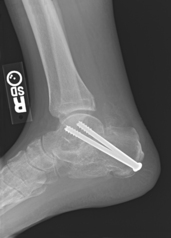
Figure 8-11. Lateral radiograph status post subtalar arthrodesis using two divergent cannulated screws.
• The patient may require bone grafting or bone block if bone loss is present from previous trauma/calcaneal fracture.
• A posterior splint is applied in the operating room after closure. The patient remains non–weight bearing for 2 weeks.
Estimated postoperative course
 Postoperative 2 weeks: sutures removed. Non–weight bearing in a boot. Remove boot multiple times daily for ankle motion to prevent stiffness.
Postoperative 2 weeks: sutures removed. Non–weight bearing in a boot. Remove boot multiple times daily for ankle motion to prevent stiffness.
 Postoperative 6 weeks: radiograph reviewed. Start weight bearing in boot from weeks 6 to 12.
Postoperative 6 weeks: radiograph reviewed. Start weight bearing in boot from weeks 6 to 12.
 Postoperative 3 months: Transition to regular shoes at 12 weeks if fusion is radiographically healed.
Postoperative 3 months: Transition to regular shoes at 12 weeks if fusion is radiographically healed.
Ankle fractures
Physical examination
 Edema, ecchymosis, tenderness over fracture site. Medial tenderness without medial malleolus fracture suggests deltoid ligament injury; does not necessarily signify unstable ankle joint
Edema, ecchymosis, tenderness over fracture site. Medial tenderness without medial malleolus fracture suggests deltoid ligament injury; does not necessarily signify unstable ankle joint
 Fracture blisters with severe edema and soft tissue trauma
Fracture blisters with severe edema and soft tissue trauma
 Visual deformity present if ankle dislocated or severe displacement of fracture
Visual deformity present if ankle dislocated or severe displacement of fracture
 Complete neurovascular examination required. If ankle reduction performed, neurovascular examination should be repeated after reduction
Complete neurovascular examination required. If ankle reduction performed, neurovascular examination should be repeated after reduction
 Evaluation for syndesmotic injury: palpation of proximal fibula (tenderness suggests syndesmotic injury), calf compression test, external rotation test
Evaluation for syndesmotic injury: palpation of proximal fibula (tenderness suggests syndesmotic injury), calf compression test, external rotation test
Imaging
• Weight-bearing ankle AP, mortise, lateral. Assess fracture, alignment, displacement.
• Weight bearing foot AP, oblique, lateral. Assess for fracture or malalignment.
• Stress radiographs of the ankle should be performed for isolated fibular fractures at the level of the ankle joint. To perform, gravity stress or external rotation and/or abduction stress is applied in a non–weight-bearing mortise view. Medial clear space greater than 4 to 5 mm indicates deltoid ligament injury and ankle instability (Fig. 8-12).
• Compare with contralateral ankle (mortise view is best). A 2-mm side-to-side difference in medial clear space indicates instability.
• CT scans are helpful to evaluate comminution and subtle displacement. Scan should be performed of bilateral ankles to compare syndesmosis and medial clear space.
• MRIs are usually not necessary but can be useful to evaluate the deltoid ligament and help determine ankle stability.
Classification systems
 Danis-Weber classification is based on the location of the fibular fracture and does not address the medial structures.
Danis-Weber classification is based on the location of the fibular fracture and does not address the medial structures.
• Type A: Transverse fracture at the level of or distal to the tibial plafond
• Type B: Spiral, oblique fracture at the level of distal tibiofibular joint and extends proximally. Associated with possible disruption of syndesmosis (Fig. 8-13).
• Type C: Fracture proximal to distal tibiofibular joint. Syndesmosis completely disrupted; anterior and posterior tibiofibular ligaments and interosseous membrane ruptured (Fig. 8-14)
 Lauge-Hansen classification: Fracture types are described by two terms that describe the fracture mechanism. The first term is supination or pronation, and the second term is adduction or external rotation. Additional subtypes exist within each classification.
Lauge-Hansen classification: Fracture types are described by two terms that describe the fracture mechanism. The first term is supination or pronation, and the second term is adduction or external rotation. Additional subtypes exist within each classification.
Initial treatment
Treatment options
 Weber A fractures: Nearly all can be treated nonoperatively, even with mild displacement.
Weber A fractures: Nearly all can be treated nonoperatively, even with mild displacement.
• Immobilization in cast or walking boot, weight bearing as tolerated. Most fractures heal in 6 weeks.
 Weber B: Isolated Weber B fractures require thorough evaluation to determine stability. If stable, consider nonoperative treatment. Unstable fractures require open reduction, internal fixation (ORIF).
Weber B: Isolated Weber B fractures require thorough evaluation to determine stability. If stable, consider nonoperative treatment. Unstable fractures require open reduction, internal fixation (ORIF).
• Consider nonoperative management when medial clear space is less than 4 to 5 mm and less than 2 mm greater than contralateral side on stress and static radiographs.
• Immobilization in cast or walking boot for 6 weeks. Weight bearing is progressed as tolerated.
• Frequent follow-up with radiographs (weekly for first 2 to 3 weeks). Surgical fixation is recommended if there is a change in stability or alignment.
• After 6 weeks of immobilization, transition to brace. Physical therapy may be helpful to regain motion and strength.
Operative management
Codes
Operative indications
 Instability of ankle or syndesmosis, significant fracture displacement
Instability of ankle or syndesmosis, significant fracture displacement
 Open fractures require immediate surgical debridement and antibiotic therapy. Staged treatment is often used in open fractures. External fixator is initially placed to stabilize the fracture/joint followed by delayed ORIF once soft tissues allow.
Open fractures require immediate surgical debridement and antibiotic therapy. Staged treatment is often used in open fractures. External fixator is initially placed to stabilize the fracture/joint followed by delayed ORIF once soft tissues allow.
 Bimalleolar and trimalleolar fractures result in instability of mortise and surgical fixation necessary to stabilize ankle.
Bimalleolar and trimalleolar fractures result in instability of mortise and surgical fixation necessary to stabilize ankle.
 Medial malleolar fractures are often associated with injury to the deltoid ligament and most require ORIF.
Medial malleolar fractures are often associated with injury to the deltoid ligament and most require ORIF.
Informed consent and counseling
 Risks include wound complications, infection, nonunion, and DVT. The rate of complication is significantly higher in diabetics, nicotine users, and patients with peripheral vascular disease. Post-traumatic arthritis may still occur despite proper stabilization. Major structures at risk are the superficial peroneal nerve (crosses fibula approximately 4 to 5 cm proximal to joint) and saphenous vein (for medial incisions).
Risks include wound complications, infection, nonunion, and DVT. The rate of complication is significantly higher in diabetics, nicotine users, and patients with peripheral vascular disease. Post-traumatic arthritis may still occur despite proper stabilization. Major structures at risk are the superficial peroneal nerve (crosses fibula approximately 4 to 5 cm proximal to joint) and saphenous vein (for medial incisions).
Surgical procedure
 Open Reduction, Internal Fixation
Open Reduction, Internal Fixation
• Distal fibular fractures—Multiple hardware options are available including locking and nonlocking plates and screws. Locking plates should be used when bone quality is poor or a patient is at high risk for nonunion (diabetes, osteoporosis).
• Medial malleolus fractures—Fixation devices include lag, partially threaded, or cannulated screws; Kirshner wires; tension bands; and buttress plate (used only for vertical sheer fractures to prevent proximal migration of fracture fragment).
 Use a lateral approach for fixation of distal fibula, syndesmosis, and possibly posterior malleolus. Longitudinal incision is made directly over the distal fibula. Fibular fracture is reduced and stabilized, restoring proper length and rotation. Intraoperative radiograph is used for reduction, to confirm proper screw length, and to determine stability. After ORIF fibula, a radiograph is taken to evaluate medial clear space. If widening is present after ORIF fibula, a syndesmotic screw is placed (Fig. 8-15).
Use a lateral approach for fixation of distal fibula, syndesmosis, and possibly posterior malleolus. Longitudinal incision is made directly over the distal fibula. Fibular fracture is reduced and stabilized, restoring proper length and rotation. Intraoperative radiograph is used for reduction, to confirm proper screw length, and to determine stability. After ORIF fibula, a radiograph is taken to evaluate medial clear space. If widening is present after ORIF fibula, a syndesmotic screw is placed (Fig. 8-15).
 Use a medial approach for fixation of medial malleolar fracture or deltoid ligament repair. A longitudinal incision is made over medial malleolus. The saphenous vein is identified and carefully retracted.
Use a medial approach for fixation of medial malleolar fracture or deltoid ligament repair. A longitudinal incision is made over medial malleolus. The saphenous vein is identified and carefully retracted.
 Many fractures require both medial and lateral approaches.
Many fractures require both medial and lateral approaches.
 A sugar tong splint is applied before leaving the operating room, and the patient remains non–weight bearing on the affected extremity.
A sugar tong splint is applied before leaving the operating room, and the patient remains non–weight bearing on the affected extremity.
Estimated postoperative course
 Postoperative 2 to 3 weeks: Sutures removed. Radiographs are obtained at each postoperative visit until complete healing is noted.
Postoperative 2 to 3 weeks: Sutures removed. Radiographs are obtained at each postoperative visit until complete healing is noted.
 In general, the patient should be non–weight bearing with immobilization in a sugar tong splint, cast, or boot for 6 weeks postoperative. Gentle range of motion and partial weight bearing can begin 2 to 4 weeks postoperative when there is good bone quality and stable fixation. Strict immobilization and no weight bearing should be followed for full 6 weeks if there is poor bone quality, ligamentous instability, or less stable fixation.
In general, the patient should be non–weight bearing with immobilization in a sugar tong splint, cast, or boot for 6 weeks postoperative. Gentle range of motion and partial weight bearing can begin 2 to 4 weeks postoperative when there is good bone quality and stable fixation. Strict immobilization and no weight bearing should be followed for full 6 weeks if there is poor bone quality, ligamentous instability, or less stable fixation.
 Postoperative 6 weeks: Progress to full weight bearing in boot. Remove boot daily for range of motion.
Postoperative 6 weeks: Progress to full weight bearing in boot. Remove boot daily for range of motion.
 Postoperative 8 to 10 weeks: Discontinue boot and progress to shoe with ankle brace.
Postoperative 8 to 10 weeks: Discontinue boot and progress to shoe with ankle brace.
 Syndesmotic screw removal should be performed no sooner than 3 to 4 months postoperative. No definitive evidence exists to show a difference in clinical outcome whether a syndesmotic screw is removed or left in place.
Syndesmotic screw removal should be performed no sooner than 3 to 4 months postoperative. No definitive evidence exists to show a difference in clinical outcome whether a syndesmotic screw is removed or left in place.
Plantar fasciitis (PF)
 PF is the most common cause of plantar heel pain.
PF is the most common cause of plantar heel pain.
 Plantar heel pain at the distal plantar fascia (medial calcaneal tuberosity) may extend into midsubstance plantar fascia.
Plantar heel pain at the distal plantar fascia (medial calcaneal tuberosity) may extend into midsubstance plantar fascia.
 Start-up pain is characteristic of PF. Pain is greatest with the first steps in the morning or after prolonged sitting. Symptoms improve or resolve with non–weight bearing.
Start-up pain is characteristic of PF. Pain is greatest with the first steps in the morning or after prolonged sitting. Symptoms improve or resolve with non–weight bearing.
Treatment options
 Stretching should be done at minimum three times per day.
Stretching should be done at minimum three times per day.
 Dorsiflexion splints worn at night keep the ankle at neutral position to prevent calf and plantar fascia contracture. Most improvement is noted in morning symptoms.
Dorsiflexion splints worn at night keep the ankle at neutral position to prevent calf and plantar fascia contracture. Most improvement is noted in morning symptoms.
 Silicone heel cups, arch supports, custom orthotics, or over-the-counter (OTC) orthotics may be helpful. Custom inserts have no proven advantage over prefabricated inserts.
Silicone heel cups, arch supports, custom orthotics, or over-the-counter (OTC) orthotics may be helpful. Custom inserts have no proven advantage over prefabricated inserts.
 Physical therapy and iontophoresis may provide symptomatic improvement, but symptoms return within 1 month of discontinuing treatment.
Physical therapy and iontophoresis may provide symptomatic improvement, but symptoms return within 1 month of discontinuing treatment.
 Corticosteroid injections (see orthopaedic procedures, plantar fascia injection, page 310) provide focused delivery of anti-inflammatory medication. Risks include fascial rupture and fat pad atrophy. Improvement of symptoms generally lasts less than 3 months.
Corticosteroid injections (see orthopaedic procedures, plantar fascia injection, page 310) provide focused delivery of anti-inflammatory medication. Risks include fascial rupture and fat pad atrophy. Improvement of symptoms generally lasts less than 3 months.
Morton’s (intermetatarsal) neuroma
Physical examination
 Tenderness to palpation of intermetatarsal space. Pain is not reproduced with palpation of metatarsal heads or metatarsal-phalangeal (MTP) joints.
Tenderness to palpation of intermetatarsal space. Pain is not reproduced with palpation of metatarsal heads or metatarsal-phalangeal (MTP) joints.
 Mulder’s sign: Squeeze forefoot medial to lateral and apply dorsal pressure over affected web space. Positive test is audible or palpable click that causes pain.
Mulder’s sign: Squeeze forefoot medial to lateral and apply dorsal pressure over affected web space. Positive test is audible or palpable click that causes pain.
 Edema, erythema, and ecchymosis are not present, and there is ± sensory deficit at affected web space/toes and ± divergence of toes.
Edema, erythema, and ecchymosis are not present, and there is ± sensory deficit at affected web space/toes and ± divergence of toes.
Imaging
 Radiographs: Weight-bearing foot AP, lateral, oblique. Neuromas are not visible.
Radiographs: Weight-bearing foot AP, lateral, oblique. Neuromas are not visible.
 Ultrasound and MRI: Can be used for atypical presentations, but usually not necessary. Neuroma appears as an ovoid/dumbbell-shaped plantar mass between metatarsal heads.
Ultrasound and MRI: Can be used for atypical presentations, but usually not necessary. Neuroma appears as an ovoid/dumbbell-shaped plantar mass between metatarsal heads.
 Ultrasound: A hypoechoic signal is present, but not all neuromas are visible.
Ultrasound: A hypoechoic signal is present, but not all neuromas are visible.
 MRI: Best identified on T1 images, low intensity signal. Contrast MRI can differentiate from other masses.
MRI: Best identified on T1 images, low intensity signal. Contrast MRI can differentiate from other masses.
Treatment options
 The goals are to alleviate pressure and decrease irritation of the nerve.
The goals are to alleviate pressure and decrease irritation of the nerve.
 Shoes with wide toe boxes are best. Avoid high heels.
Shoes with wide toe boxes are best. Avoid high heels.
 Metatarsal pads placed proximal to metatarsal heads spread apart the metatarsal heads and decrease pressure on nerve.
Metatarsal pads placed proximal to metatarsal heads spread apart the metatarsal heads and decrease pressure on nerve.
 Corticosteroid injections (see orthopaedic procedures, Morton’s neuroma injection, page 311) have variable results. Multiple injections have higher success rates (reported resolution of symptoms 11% to 47%). Risks of injections include atrophy of plantar fat pad and MTP joint subluxation.
Corticosteroid injections (see orthopaedic procedures, Morton’s neuroma injection, page 311) have variable results. Multiple injections have higher success rates (reported resolution of symptoms 11% to 47%). Risks of injections include atrophy of plantar fat pad and MTP joint subluxation.
Surgical procedure
• Dorsal approach: A longitudinal incision is made over the involved web space. The dorsal interosseous fascia is split and retracted. Interosseous muscle is partially detached, metatarsal heads are retracted, and the intermetatarsal ligament is cut. The neuroma is exposed by retracting the digital artery and lumbrical muscle.
• Plantar approach: This is generally reserved for revision procedures. A longitudinal incision is made between the metatarsal heads. The plantar fascia is split and retracted to expose the neuroma.
• Once neuroma is exposed, it is dissected proximally and cut. The proximal stump retracts into the intrinsic muscles.
• Evaluate vascular status after excision to ensure digital artery intact and functioning.
Estimated postoperative course
 Dorsal approach: weight bearing as tolerated in hard-soled post-operative shoe. Progress to normal shoe wear and activities as tolerated once incision healed, usually between 2 and 3 weeks postoperative.
Dorsal approach: weight bearing as tolerated in hard-soled post-operative shoe. Progress to normal shoe wear and activities as tolerated once incision healed, usually between 2 and 3 weeks postoperative.
 The plantar approach requires greater protection with a splint or cast boot and more limited weight bearing to prevent wound complications. Sutures are removed 2 to 3 weeks postoperative. Progress to normal shoe wear and activities as tolerated once the wound has completely healed. This may be 3 to 4 weeks postoperative.
The plantar approach requires greater protection with a splint or cast boot and more limited weight bearing to prevent wound complications. Sutures are removed 2 to 3 weeks postoperative. Progress to normal shoe wear and activities as tolerated once the wound has completely healed. This may be 3 to 4 weeks postoperative.
Diabetic foot and charcot arthropathy
 Diabetics with neuropathy are at high risk for developing ulcers and infections.
Diabetics with neuropathy are at high risk for developing ulcers and infections.
 Symptoms of neuropathy are numbness, paresthesias or dysesthesias, slow wound healing, and no pain after injury.
Symptoms of neuropathy are numbness, paresthesias or dysesthesias, slow wound healing, and no pain after injury.
 Charcot arthropathy is a destructive disease of bones and joints that occurs in sensory neuropathy. It is noninfectious and progressive. Unilateral involvement occurs at initial presentation.
Charcot arthropathy is a destructive disease of bones and joints that occurs in sensory neuropathy. It is noninfectious and progressive. Unilateral involvement occurs at initial presentation.
 Charcot arthropathy can develop in patients with diabetic neuropathy. The average duration of diabetes at onset is 20 to 24 years for type I and 5 to 9 years for type II.
Charcot arthropathy can develop in patients with diabetic neuropathy. The average duration of diabetes at onset is 20 to 24 years for type I and 5 to 9 years for type II.
 Risk factors for ulcers are peripheral neuropathy; absent pedal pulses; claudication; trophic skin changes (decreased hair growth, skin discoloration or atrophy); history of ulcer; and hospitalization for foot infection, bony deformity, or peripheral edema.
Risk factors for ulcers are peripheral neuropathy; absent pedal pulses; claudication; trophic skin changes (decreased hair growth, skin discoloration or atrophy); history of ulcer; and hospitalization for foot infection, bony deformity, or peripheral edema.
Physical examination
 Visual deformities: Claw-toe deformities are common from loss of intrinsic muscle tone. Rocker-bottom midfoot deformity is often present in Charcot arthropathy of midfoot.
Visual deformities: Claw-toe deformities are common from loss of intrinsic muscle tone. Rocker-bottom midfoot deformity is often present in Charcot arthropathy of midfoot.
• Inspect for presence of corns or calluses, open wounds, swelling, trophic changes, dependent rubor (arterial insufficiency), and bony prominences.
• Ulcers often develop at sites of callus formation or as a result of microtrauma.
• Increased warmth compared with the contralateral side can indicate Charcot arthropathy, venous insufficiency, or infection.
 Sensory examination: Conduct monofilament testing (Semmes-Weinstein) for loss of protective sensation. The threshold for peripheral neuropathy is 10 grams. Generalized neuropathy with diminished sensation in “stocking” distribution is characteristic of diabetic neuropathy.
Sensory examination: Conduct monofilament testing (Semmes-Weinstein) for loss of protective sensation. The threshold for peripheral neuropathy is 10 grams. Generalized neuropathy with diminished sensation in “stocking” distribution is characteristic of diabetic neuropathy.
 Vascular: Decreased or absent pedal pulses indicate peripheral vascular disease. Delayed capillary refill indicates ischemic disease.
Vascular: Decreased or absent pedal pulses indicate peripheral vascular disease. Delayed capillary refill indicates ischemic disease.
Imaging
 Radiograph: weight-bearing AP, lateral, oblique of foot and AP, lateral, mortise of ankle
Radiograph: weight-bearing AP, lateral, oblique of foot and AP, lateral, mortise of ankle
• May be normal in early disease processes
• Difficult to differentiate Charcot arthropathy from osteomyelitis
• Charcot arthropathy: disorganization of bony structure, bony erosion, intra-articular loose bodies, may have subluxation or dislocation of joints (Fig. 8-16)
 Nuclear medicine: Bone scan with indium labeled leukocyte scintigraphy useful to diagnosis osteomyelitis; 93% to 100% sensitivity, 80% specificity
Nuclear medicine: Bone scan with indium labeled leukocyte scintigraphy useful to diagnosis osteomyelitis; 93% to 100% sensitivity, 80% specificity
Classification systems
 Multiple classification systems for diabetic foot ulcers, and Charcot arthropathy
Multiple classification systems for diabetic foot ulcers, and Charcot arthropathy
 Pinzer “risk factor” system to guide treatment of diabetic patients
Pinzer “risk factor” system to guide treatment of diabetic patients
• Risk Category 0: Normal appearance and sensation, mild to no deformity
• Risk Category 1: Normal appearance, insensate, no deformity
• Risk Category 2: Insensate foot with deformity, no history of prior ulcer
• Risk Category 3: Insensate foot with deformity and history of prior ulcer
 Classification system of Charcot arthropathy:
Classification system of Charcot arthropathy:
• Stage 0: Clinical examination findings of erythema and edema. Radiographs are normal.
• Stage I: Fragmentation or dissolution phase. Radiographs demonstrate periarticular fragmentation, subluxation, or dislocation of joint. On examination, foot is warm, edematous, and erythematous.
• Stage II: Coalescence period, early healing phase. Radiographs show early sclerosis, fusion of bony fragments, and absorption of debris. On examination, there is less erythema and warmth than stage I.
• Stage III: Reconstruction phase. Radiographs reveal subchondral sclerosis, osteophytes, and narrow or absent joint spaces. On examination, visual deformity is present and there is no acute inflammation.
Treatment options
 At-risk patients without Charcot arthropathy: based on Pinzur classification
At-risk patients without Charcot arthropathy: based on Pinzur classification
• Risk Category 0: education, normal footwear, yearly clinical examination
• Risk Category 1: education, daily foot self-examination, protective over-the-counter insoles, appropriate footwear, biannual clinical examination
• Risk Category 2: education, daily foot self-examination, custom pressure-dissipating accommodative orthoses, inlay depth soft-leather shoes, clinical examination every 4 months
• Risk Category 3: education, daily foot self-examination, custom pressure-dissipating orthoses, inlay depth soft-leather shoes, clinical examination every 2 months
 Charcot arthropathy: based on stage
Charcot arthropathy: based on stage
• Stage I: immobilization using total contact casting, which reduces total load on the foot by one third. Length of immobilization depends on progression of disease/collapse, often 2 to 4 months.
• Stage II: ankle-foot orthosis or Charcot restraint orthotic walker (CROW) boot.
• Stage III: accommodative shoe and custom insole to decrease pressure on bony prominences
Surgical procedures
 Amputation: Level of amputation and surgical techniques vary, depending on disease involvement.
Amputation: Level of amputation and surgical techniques vary, depending on disease involvement.
 Arthrodesis: As described in earlier sections of the chapter
Arthrodesis: As described in earlier sections of the chapter
Metatarsal fractures (including jones fracture)
Imaging
Classification system
 Fifth metatarsal fractures are classified on the basis of location. Treatment recommendations are based on this classification system.
Fifth metatarsal fractures are classified on the basis of location. Treatment recommendations are based on this classification system.
• Zone 1 (avulsion): Fifth metatarsal tuberosity fracture. Most common type (>90%). Often extends from insertion of peroneal brevis to involve the tarsometarsal joint.
• Zone 2 (Jones fracture): Distal to the tuberosity at metaphyseal-diaphyseal junction. Fracture extends to fourth to fifth intermetatarsal joint. Mechanism is adduction or inversion of the forefoot (Fig. 8-18).

Figure 8-18. Jones fracture of the fifth metatarsal.
• Zone 3: Proximal diaphyseal shaft fracture. Rare, less than 3% of fifth MT fractures. Frequently a stress injury and patients may report prodromal pain.
Treatment options
• First MT fractures nondisplaced, stable: immobilization (short leg cast or cast boot) for 6 weeks, weight bearing as tolerated.
• Lesser MT fractures nondisplaced or mild displacement (<4 mm translation, ≤10-degree sagittal angulation): hard-sole shoe for 4 to 6 weeks, weight bearing as tolerated.
• Zone 1: hard-soled shoe or short cast boot for 4 to 6 weeks, weight bearing as tolerated. Consider ORIF for significantly displaced fractures.
• Zone 2: short leg cast immobilization for 6 to 8 weeks, non–weight bearing.
• Concern for nonunion with nonoperative treatment exists, especially in noncompliant patients. ORIF is recommended for high-level athletes.
• Zone 3: high risk of nonunion, most surgeons recommend ORIF. If nonoperative treatment used, short leg cast immobilization with protected weight bearing for up to 3 months.
Operative management
Operative indications
 Significantly displaced fracture or fracture in Zone 2 or 3. Treatment of Zone 2 fractures is controversial and can be treated operatively or nonoperatively.
Significantly displaced fracture or fracture in Zone 2 or 3. Treatment of Zone 2 fractures is controversial and can be treated operatively or nonoperatively.
 ORIF or percutaneous pinning is recommended for fractures with significant displacement. Approach and exact procedure depend on location and fracture type.
ORIF or percutaneous pinning is recommended for fractures with significant displacement. Approach and exact procedure depend on location and fracture type.
Surgical procedure
Orif fifth metatarsal fracture
 Procedure: Screw fixation of fifth metatarsal fracture Zone 2 (Jones fracture)
Procedure: Screw fixation of fifth metatarsal fracture Zone 2 (Jones fracture)
• Longitudinal incision is made proximal to base of the metatarsal just dorsal to the border of the dorsal and plantar skin. Dissection performed down to bone.
• A guidewire is used to access the intramedullary canal from dorsal and medial position, under guidance of an intraoperative radiograph. Screw length is determined, and a 5.5-mm screw is placed across the fracture. The screw should be long enough for half of the threads to cross the fracture site. The screw is countersunk to decrease the risk of soft tissue irritation postoperatively. Due to the bend of the fifth MT, a screw with excess length can increase varus stress and result in a nonunion (Fig. 8-19).
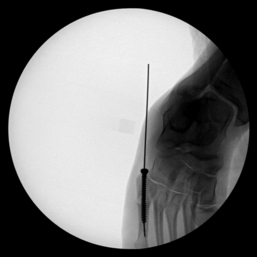
Figure 8-19. Intraoperative radiograph demonstrating guidewire and screw placement for fixation of fifth metatarsal fracture.
• A sugar tong splint is applied before leaving the operating room, and the patient is non–weight bearing for 2 weeks.
Lisfranc fracture/injury (tarsometatarsal joint complex injury)
 The Lisfranc ligament is a strong, interosseous attachment between the medial cuneiform and second metatarsal. A Lisfranc fracture describes an injury to the base of the metatarsal(s) at the attachment to the distal tarsal bones and Lisfranc ligament.
The Lisfranc ligament is a strong, interosseous attachment between the medial cuneiform and second metatarsal. A Lisfranc fracture describes an injury to the base of the metatarsal(s) at the attachment to the distal tarsal bones and Lisfranc ligament.
 Mechanism is trauma. About two thirds of injuries result from high-energy trauma (motor vehicle crash [MVC], fall from height), and one third result from lower-energy mechanisms (e.g., athletics).
Mechanism is trauma. About two thirds of injuries result from high-energy trauma (motor vehicle crash [MVC], fall from height), and one third result from lower-energy mechanisms (e.g., athletics).
 Symptoms include pain, inability to weight bear on affected foot, swelling, and bruising.
Symptoms include pain, inability to weight bear on affected foot, swelling, and bruising.
 Most injuries are subtle, and many are missed on first evaluation and radiograph.
Most injuries are subtle, and many are missed on first evaluation and radiograph.
Imaging
 Radiograph: weight-bearing AP, lateral, oblique of the foot. Include weight-bearing AP with both feet on same film for comparison.
Radiograph: weight-bearing AP, lateral, oblique of the foot. Include weight-bearing AP with both feet on same film for comparison.
• Most common finding in Lisfranc injury is lateral step-off at second tarsometatarsal (TMT) joint.
• Normal/uninjured foot: Medial border of second MT and medial border of middle cuneiform align on AP view. Oblique view demonstrates alignment of medial border fourth MT and medial border of cuboid (Fig. 8-20).
• If radiographs appear normal, but high suspicion for Lisfranc injury, evaluate with CT scan or MRI.
 CT scan: can be used to evaluate subtle or occult fractures. CT scans allow for more precise evaluation of fractures including comminution and intra-articular extension (Fig. 8-21).
CT scan: can be used to evaluate subtle or occult fractures. CT scans allow for more precise evaluation of fractures including comminution and intra-articular extension (Fig. 8-21).
 MRI: can be used to evaluate soft tissues including Lisfranc ligament. MRI is used less frequently than CT scan to evaluate Lisfranc injuries.
MRI: can be used to evaluate soft tissues including Lisfranc ligament. MRI is used less frequently than CT scan to evaluate Lisfranc injuries.
Initial treatment
Treatment options
 Consider nonoperative management for stable injuries (no subluxation on radiograph or CT, no ligament tear on MRI, and negative stress examination under anesthesia).
Consider nonoperative management for stable injuries (no subluxation on radiograph or CT, no ligament tear on MRI, and negative stress examination under anesthesia).
 Immobilize in cast boot for 6 to 10 weeks, and bear weight as tolerated.
Immobilize in cast boot for 6 to 10 weeks, and bear weight as tolerated.
 Repeat weight-bearing radiographs 2 weeks postinjury. If there is a change in alignment, consider ORIF.
Repeat weight-bearing radiographs 2 weeks postinjury. If there is a change in alignment, consider ORIF.
 After 6 to 10 weeks of immobilization, physical therapy may be indicated for gait training, balance, and functional strengthening. Full recovery occurs approximately 4 months postinjury.
After 6 to 10 weeks of immobilization, physical therapy may be indicated for gait training, balance, and functional strengthening. Full recovery occurs approximately 4 months postinjury.
 If pain is persistent in the future, midfoot arthrodesis can be performed.
If pain is persistent in the future, midfoot arthrodesis can be performed.
 Nonoperative treatment is recommended for low-demand patients (little ambulation or nonambulatory), preexisting inflammatory arthritis, or insensate foot.
Nonoperative treatment is recommended for low-demand patients (little ambulation or nonambulatory), preexisting inflammatory arthritis, or insensate foot.
Surgical procedure
Open reduction internal fixation
 Dorsal incision is made over the involved joint of midfoot. Many fixation techniques can be used, and multiple devices are available. Common techniques include screw fixation, dorsal plating, and Kirschner wires (most common for fourth or fifth TMT injuries).
Dorsal incision is made over the involved joint of midfoot. Many fixation techniques can be used, and multiple devices are available. Common techniques include screw fixation, dorsal plating, and Kirschner wires (most common for fourth or fifth TMT injuries).
 Fractures are reduced, alignment of TMT joints is corrected, and hardware is placed. Intraoperative radiograph is used to determine alignment and correct placement of hardware (Fig. 8-22).
Fractures are reduced, alignment of TMT joints is corrected, and hardware is placed. Intraoperative radiograph is used to determine alignment and correct placement of hardware (Fig. 8-22).

Figure 8-22. Postoperative oblique view of open reduction, internal fixation first, second, and third tarsometatarsal joints.
 A sugar tong splint is applied before leaving the operating room, and the patient is non–weight bearing.
A sugar tong splint is applied before leaving the operating room, and the patient is non–weight bearing.
Estimated postoperative course
 Postoperative 2 weeks: Sutures are removed at about 2 weeks, and the patient is transitioned to a short leg cast
Postoperative 2 weeks: Sutures are removed at about 2 weeks, and the patient is transitioned to a short leg cast
 Postoperative 4 to 6 weeks: Apply walking boot and begin partial weight bearing. K-wires are removed at about 6 weeks postoperative if present.
Postoperative 4 to 6 weeks: Apply walking boot and begin partial weight bearing. K-wires are removed at about 6 weeks postoperative if present.
 Postoperative 8 weeks: Progress to full weight bearing in a cast boot. Continue boot for 3 to 4 months postoperative.
Postoperative 8 weeks: Progress to full weight bearing in a cast boot. Continue boot for 3 to 4 months postoperative.
 Hardware removal performed about 4 months postoperative. Use walking boot, and bear weight as tolerated for 2 to 4 weeks after hardware removal. Progress to normal shoe full weight bearing.
Hardware removal performed about 4 months postoperative. Use walking boot, and bear weight as tolerated for 2 to 4 weeks after hardware removal. Progress to normal shoe full weight bearing.
Phalangeal fractures
 Common mechanisms include stubbing a toe or a direct blow from a falling object.
Common mechanisms include stubbing a toe or a direct blow from a falling object.
 Symptoms include pain, swelling, bruising, and difficulty walking or wearing a shoe.
Symptoms include pain, swelling, bruising, and difficulty walking or wearing a shoe.
 Sesamoid fractures are caused by overuse or avulsion forces or direct trauma. Patients report pain directly under the first MTP joint with weight bearing. The medial (tibial) sesamoid is more commonly injured than the lateral (fibular).
Sesamoid fractures are caused by overuse or avulsion forces or direct trauma. Patients report pain directly under the first MTP joint with weight bearing. The medial (tibial) sesamoid is more commonly injured than the lateral (fibular).
Treatment options
 Nearly all phalangeal fractures can be treated nonoperatively.
Nearly all phalangeal fractures can be treated nonoperatively.
 Displaced fractures of lesser toes can be treated with closed reduction with traction after digital block. After reduction, splint to adjacent toe (buddy taping) for 2 to 4 weeks. Weight bearing as tolerated in hard-soled shoe for 4 to 6 weeks.
Displaced fractures of lesser toes can be treated with closed reduction with traction after digital block. After reduction, splint to adjacent toe (buddy taping) for 2 to 4 weeks. Weight bearing as tolerated in hard-soled shoe for 4 to 6 weeks.
 Nondisplaced fractures of the great toe require immobilization in hard-soled shoe or boot for 2 to 3 weeks, weight bearing as tolerated primarily through heel.
Nondisplaced fractures of the great toe require immobilization in hard-soled shoe or boot for 2 to 3 weeks, weight bearing as tolerated primarily through heel.
 Sesamoid fractures: cast boot with sesamoid orthotic (dancer’s pad) for 6 weeks, then transition to shoe with sesamoid orthotic for an additional 6 weeks.
Sesamoid fractures: cast boot with sesamoid orthotic (dancer’s pad) for 6 weeks, then transition to shoe with sesamoid orthotic for an additional 6 weeks.
Tarsal tunnel syndrome
 Tarsal tunnel syndrome may present with a history of injury or trauma.
Tarsal tunnel syndrome may present with a history of injury or trauma.
 Patients complain of burning, tingling, and numbness over the plantar aspect of the foot, which may radiate distally or proximally. Symptoms increase with protracted walking or standing and resolve with rest, elevation, and loose shoes. Patients may experience severe pain at night.
Patients complain of burning, tingling, and numbness over the plantar aspect of the foot, which may radiate distally or proximally. Symptoms increase with protracted walking or standing and resolve with rest, elevation, and loose shoes. Patients may experience severe pain at night.
 Obtain history related to systemic disorders that can affect nerves (i.e., rheumatologic disorders, diabetes, Lyme disease, thyroid disorder).
Obtain history related to systemic disorders that can affect nerves (i.e., rheumatologic disorders, diabetes, Lyme disease, thyroid disorder).
Physical examination
Treatment options
 Most effective when underlying etiology is tenosynovitis or foot deformity
Most effective when underlying etiology is tenosynovitis or foot deformity
 Includes use of corticosteroid injection, orthotics, NSAIDS, and immobilization (see Tarsal Tunnel Injection, page 311)
Includes use of corticosteroid injection, orthotics, NSAIDS, and immobilization (see Tarsal Tunnel Injection, page 311)
 Can consider prescribing medications such as tricyclic antidepressants, selective serotonin reuptake inhibitors (SSRIs), antiseizure medication, or other antidepressants. Refer patient to pain management or neurologist if not comfortable prescribing these medications.
Can consider prescribing medications such as tricyclic antidepressants, selective serotonin reuptake inhibitors (SSRIs), antiseizure medication, or other antidepressants. Refer patient to pain management or neurologist if not comfortable prescribing these medications.
Operative management
Informed consent and counseling
 Risks and complications include continued pain despite release, increased symptoms, numbness dysesthesias, persistent tenderness or paresthesias over the tarsal tunnel, edema, nerve damage, vascular damage, infection, wound complications, difficulty with footwear, and causalgia or complex regional pain syndrome type 2
Risks and complications include continued pain despite release, increased symptoms, numbness dysesthesias, persistent tenderness or paresthesias over the tarsal tunnel, edema, nerve damage, vascular damage, infection, wound complications, difficulty with footwear, and causalgia or complex regional pain syndrome type 2
Surgical procedures
 Curved medial incision extending above, behind, and below the medial malleolus beginning 10 cm proximal to medial malleolus and 2 cm posterior to tibia
Curved medial incision extending above, behind, and below the medial malleolus beginning 10 cm proximal to medial malleolus and 2 cm posterior to tibia
 Incision is deepened to expose flexor retinaculum. Tibial nerve sheath is identified and opened proximally. Flexor retinaculum is then carefully released.
Incision is deepened to expose flexor retinaculum. Tibial nerve sheath is identified and opened proximally. Flexor retinaculum is then carefully released.
 Terminal branches of tibial nerve should be identified and released
Terminal branches of tibial nerve should be identified and released
 Wound closed in layers, leaving retinaculum open
Wound closed in layers, leaving retinaculum open
 Patient placed in well-molded posterior splint, non–weight bearing
Patient placed in well-molded posterior splint, non–weight bearing
Estimated postoperative course
Achilles tendinopathy and rupture
History
 Sharp unexpected dorsiflexion force to the ankle in conjunction with a strong contraction of the calf (e.g., tripping on a curb, unexpectedly stepping into a hole), pushing off the weight-bearing foot with the knee in extension (e.g., lunging for a tennis shot), and a strong or violent dorsiflexion force on a plantar-flexed ankle (e.g., jumping from a height)
Sharp unexpected dorsiflexion force to the ankle in conjunction with a strong contraction of the calf (e.g., tripping on a curb, unexpectedly stepping into a hole), pushing off the weight-bearing foot with the knee in extension (e.g., lunging for a tennis shot), and a strong or violent dorsiflexion force on a plantar-flexed ankle (e.g., jumping from a height)
 Sensation of a snap or audible pop in posterior calf followed by acute pain like “got kicked from behind” or sounds “like a gun being shot”, difficulty walking, and weakened plantarflexion.
Sensation of a snap or audible pop in posterior calf followed by acute pain like “got kicked from behind” or sounds “like a gun being shot”, difficulty walking, and weakened plantarflexion.
Physical examination
 Palpable defect approximately 2 to 6 cm from insertion of Achilles tendon
Palpable defect approximately 2 to 6 cm from insertion of Achilles tendon
 Increased ankle dorsiflexion ROM and decreased plantarflexion strength compared with uninjured extremity
Increased ankle dorsiflexion ROM and decreased plantarflexion strength compared with uninjured extremity
 Positive Thompson test: assesses the continuity of Achilles tendon. Patient is placed in a prone position with both feet extended past end of examination table. The affected calf is squeezed, and reflex plantarflexion is assessed. A positive test is when there is no reflex plantarflexion with a squeeze of the calf.
Positive Thompson test: assesses the continuity of Achilles tendon. Patient is placed in a prone position with both feet extended past end of examination table. The affected calf is squeezed, and reflex plantarflexion is assessed. A positive test is when there is no reflex plantarflexion with a squeeze of the calf.
Initial treatment
 Acute Achilles ruptures may be treated surgically or nonsurgically with similar outcomes with appropriate patient selection. Nonsurgical treatment has lower complication rates; however, surgical repair has a faster recovery time, quicker return to sport activities, and slightly lower re-rupture rates. Missed or improperly treated ruptures can lead to significant weakness and altered gait mechanics.
Acute Achilles ruptures may be treated surgically or nonsurgically with similar outcomes with appropriate patient selection. Nonsurgical treatment has lower complication rates; however, surgical repair has a faster recovery time, quicker return to sport activities, and slightly lower re-rupture rates. Missed or improperly treated ruptures can lead to significant weakness and altered gait mechanics.
Treatment options
 With dynamic ultrasound or MRI imaging, rupture gap must be less than 5 mm with maximum plantarflexion, less than 10-mm gap with foot in neutral dorsiflexion, or greater than 75% apposition of tendon in 20 degrees of plantarflexion
With dynamic ultrasound or MRI imaging, rupture gap must be less than 5 mm with maximum plantarflexion, less than 10-mm gap with foot in neutral dorsiflexion, or greater than 75% apposition of tendon in 20 degrees of plantarflexion
 Good candidates for non-operative management include those with systemic disease, medical comorbidities, smokers, and diabetics, as well as healthy individuals who meet the previously mentioned criteria and do not want to have surgery
Good candidates for non-operative management include those with systemic disease, medical comorbidities, smokers, and diabetics, as well as healthy individuals who meet the previously mentioned criteria and do not want to have surgery
 Treatment protocol (Table 8-5)
Treatment protocol (Table 8-5)
Table 8-5.
Nonoperative Treatment Protocol for Achilles Tendon Rupture
| Initial Evaluation | Ultrasound (U/S) or magnetic resonance imaging (MRI) examination showing < 5 mm gap of tendon ends with maximal plantarflexion, <10 mm gap with neutral, or >75% apposition of tendon ends in 20 degrees PF. |
| Initial Management | Cast in full PF, non–weight bearing |
| 2-wk evaluation | May transition to pneumatic walking boot or bivalved cast with foot in 20 degrees PF with two 1-cm heel wedges, may be weight bearing. Must wear boot 24 hours/day |
| 4-wk evaluation | On examination, palpable continuity of tendon. If concern tendon not apposed, order repeat U/S or MRI. Patient may remove boot 5 minutes per hour to perform active dorsiflexion to neutral with passive plantarflexion. |
| 6-wk evaluation | On examination, continue to document continuity of tendon. Patient may remove one 1-cm lift. Continue range-of-motion exercises, may initiate more formal physical therapy protocol. |
| 8-wk evaluation | Document continued continuity of tendon. May decrease to zero lifts in boot and discontinue use of boot at night. Continue therapy program. |
| 10-wk evaluation | Discontinue use of boot and transition into a shoe with one 1-cm heel lift to be used for 3 additional months. Continue therapy program, and avoid aggressive sport activity until heel lift is discontinued. |
Surgical procedure
Primary repair of achilles tendon rupture
 10-cm incision made 0.5 cm medial to Achilles tendon and extended proximally to insertion
10-cm incision made 0.5 cm medial to Achilles tendon and extended proximally to insertion
 Dissection down to peritenon, which is then cut longitudinally to expose ruptured tendon, care is taken not to undermine the skin
Dissection down to peritenon, which is then cut longitudinally to expose ruptured tendon, care is taken not to undermine the skin
 Ankle plantarflexed to approximate tendon ends, hematoma debrided
Ankle plantarflexed to approximate tendon ends, hematoma debrided
 Nonabsorbable suture is used to repair the rupture using a modified Kessler, Bunnell, or Krackow stitch
Nonabsorbable suture is used to repair the rupture using a modified Kessler, Bunnell, or Krackow stitch
 Peritenon is closed and skin sutured
Peritenon is closed and skin sutured
 Patient placed in non–weight bearing, well-padded, molded posterior splint in plantarflexion
Patient placed in non–weight bearing, well-padded, molded posterior splint in plantarflexion
Estimated postoperative course
 Early protected weight bearing and use of protective device that allows mobilization is key in successful rehabilitation of Achilles tendon ruptures
Early protected weight bearing and use of protective device that allows mobilization is key in successful rehabilitation of Achilles tendon ruptures
• Postoperative splint removed and wound inspected, well-healed sutures removed. If not, patient placed back into short leg cast for 1 week
• Once sutures removed, patient placed in removable boot with 2 heel wedges and allowed to initiate weight bearing as tolerated
• Heel wedges are gradually decreased over the course of the next 2 to 3 weeks, until the patient is weight bearing in the boot with no lifts
• Boot is discontinued after 1 week of weight bearing in boot with no lifts
• Physical therapy program initiated
• Patient may increase activities as tolerated after discontinuing use of boot, starting with nonimpact activities. Most people do not return to sport activity until at least 6 months after surgery.
Achilles tendinopathy
 Due to overuse injuries with primary contributing factors of host susceptibility and mechanical overload
Due to overuse injuries with primary contributing factors of host susceptibility and mechanical overload
 Associated with advancing age, usually insidious and chronic in nature
Associated with advancing age, usually insidious and chronic in nature
 Patient complains of pain in Achilles tendon with activities, thickness or edema of tendon, and impaired performance. May be related to training errors and inappropriate footwear.
Patient complains of pain in Achilles tendon with activities, thickness or edema of tendon, and impaired performance. May be related to training errors and inappropriate footwear.
Initial treatment
 This condition is likely chronic and noninflammatory in nature. It responds well to a specific rehabilitation program in which the patient’s compliance is crucial in its success. The goal of treatment is symptomatic only. The patient may always have thickened tendon or calcaneal bony prominence unless he or she undergoes surgical intervention. Recovery may follow a prolonged time course, taking 4 to 6 months before noticing improvement and even longer until the patient is back to reasonable activities comfortably.
This condition is likely chronic and noninflammatory in nature. It responds well to a specific rehabilitation program in which the patient’s compliance is crucial in its success. The goal of treatment is symptomatic only. The patient may always have thickened tendon or calcaneal bony prominence unless he or she undergoes surgical intervention. Recovery may follow a prolonged time course, taking 4 to 6 months before noticing improvement and even longer until the patient is back to reasonable activities comfortably.
Treatment options
 Mainstay of treatment, especially for patients with no prior formal treatment
Mainstay of treatment, especially for patients with no prior formal treatment
 Eccentric loading proven to be beneficial in treatment of symptoms but may take up to 12 weeks to notice improvements in symptoms
Eccentric loading proven to be beneficial in treatment of symptoms but may take up to 12 weeks to notice improvements in symptoms
 Immobilization in walking cast or boot necessary initially if symptoms severe
Immobilization in walking cast or boot necessary initially if symptoms severe
 Physical therapy prescription for Alfredson’s 12-week Eccentric Loading Protocol
Physical therapy prescription for Alfredson’s 12-week Eccentric Loading Protocol
 Follow-up in 4 to 6 months if no significant improvement to discuss possible need for surgical intervention
Follow-up in 4 to 6 months if no significant improvement to discuss possible need for surgical intervention
Operative management
Informed consent and counseling
 Risks include infection and wound complications, which can be catastrophic, painful scar; nerve injury; and continued pain.
Risks include infection and wound complications, which can be catastrophic, painful scar; nerve injury; and continued pain.
 In cases where there is a missed Achilles tendon rupture or more than 50% of the tendon is debrided, a flexor hallucis longus (FHL) tendon transfer is necessary to augment Achilles.
In cases where there is a missed Achilles tendon rupture or more than 50% of the tendon is debrided, a flexor hallucis longus (FHL) tendon transfer is necessary to augment Achilles.
Surgical procedures
Achilles tendon reconstruction using flexor hallicus longus (FHL) transfer
 Longitudinal incision made medial to Achilles tendon from musculotendinous junction to 2 cm distal to insertion
Longitudinal incision made medial to Achilles tendon from musculotendinous junction to 2 cm distal to insertion
 Peritenon incised, and Achilles tendon inspected and debrided
Peritenon incised, and Achilles tendon inspected and debrided
 Flexor hallicus longus muscle belly exposed by retracting posterior tibial artery, vein, and nerve and incising deep posterior compartment
Flexor hallicus longus muscle belly exposed by retracting posterior tibial artery, vein, and nerve and incising deep posterior compartment
 FHL harvested distally through a second longitudinal incision made along the medial border of the foot; pulled through the proximal wound and passed through a calcaneal drill hole made 1 cm distal and 1 cm anterior to Achilles tendon insertion; and FHL secured through the drill hole or through suture to anterior aspect of Achilles tendon
FHL harvested distally through a second longitudinal incision made along the medial border of the foot; pulled through the proximal wound and passed through a calcaneal drill hole made 1 cm distal and 1 cm anterior to Achilles tendon insertion; and FHL secured through the drill hole or through suture to anterior aspect of Achilles tendon
 Peritenon repaired followed by wound closure
Peritenon repaired followed by wound closure
 Patient placed in posterior mold splint in slight plantarflexion
Patient placed in posterior mold splint in slight plantarflexion
Estimated postoperative course
 Postoperative course similar to recovery for acute rupture repair; may be delayed only if tendon transfer used to augment the Achilles tendon
Postoperative course similar to recovery for acute rupture repair; may be delayed only if tendon transfer used to augment the Achilles tendon
• Splint and sutures removed; patient placed into cast or boot in 10 to 20 degrees of plantarflexion
Ankle sprain
 Inversion injury in plantar-flexed position
Inversion injury in plantar-flexed position
 Injury to lateral ligamentous complex including the anterior talofibular ligament (ATFL), calcaneofibular ligament (CFL), and posterior talofibular ligament (PTFL)
Injury to lateral ligamentous complex including the anterior talofibular ligament (ATFL), calcaneofibular ligament (CFL), and posterior talofibular ligament (PTFL)
 External rotation forces in syndesmotic sprains or high ankle sprain
External rotation forces in syndesmotic sprains or high ankle sprain
 Patients complain of pain, swelling, bruising, inability to bear weight, and loss of functional ability
Patients complain of pain, swelling, bruising, inability to bear weight, and loss of functional ability
Physical examination
 Lateral ankle edema and ecchymosis exist.
Lateral ankle edema and ecchymosis exist.
 Tenderness to palpation occurs over ATFL and CFL.
Tenderness to palpation occurs over ATFL and CFL.
 Anterior drawer test to assess injury to ATFL (Fig. 8-23): The patient is seated with the leg hanging off the side of the bed or table with the knee bent, the tibia is stabilized with one hand, and the foot is translated anteriorly with the other hand at the level of the heel. With sprain or partial rupture of ligaments, pain may be elicited. With a complete tear, the patient may demonstrate a suction sign.
Anterior drawer test to assess injury to ATFL (Fig. 8-23): The patient is seated with the leg hanging off the side of the bed or table with the knee bent, the tibia is stabilized with one hand, and the foot is translated anteriorly with the other hand at the level of the heel. With sprain or partial rupture of ligaments, pain may be elicited. With a complete tear, the patient may demonstrate a suction sign.
 Conduct an inversion stress test to assess injury to the CFL: With the ankle in neutral or slightly dorsiflexed position, invert the ankle by grasping the lateral calcaneus. This may elicit pain with injury to the CFL.
Conduct an inversion stress test to assess injury to the CFL: With the ankle in neutral or slightly dorsiflexed position, invert the ankle by grasping the lateral calcaneus. This may elicit pain with injury to the CFL.
 Use squeeze test or cross-legged test to assess syndesmotic injury: A positive result occurs when a squeeze of the proximal calf causes pain in the distal syndesmosis. Squeezing the calf will cause separation of the distal fibula and anterior tibiofibular ligament and therefore, if injured, elicits discomfort.
Use squeeze test or cross-legged test to assess syndesmotic injury: A positive result occurs when a squeeze of the proximal calf causes pain in the distal syndesmosis. Squeezing the calf will cause separation of the distal fibula and anterior tibiofibular ligament and therefore, if injured, elicits discomfort.
Imaging
 Radiograph: Weight-bearing foot (AP/oblique/lateral) and ankle (AP/mortise/lateral) if indicated per Ottawa Rules for Ankle radiographs (can be any one of the following):
Radiograph: Weight-bearing foot (AP/oblique/lateral) and ankle (AP/mortise/lateral) if indicated per Ottawa Rules for Ankle radiographs (can be any one of the following):
• Bone tenderness along distal 6 cm of posterior tibia or medial malleolus
• Bone tenderness along distal 6 cm of the fibula or lateral malleolus
 MRI or CT if ankle sprain symptomatic for more than 6 weeks to assess for osteochondral injury, tendon injury, or missed fracture
MRI or CT if ankle sprain symptomatic for more than 6 weeks to assess for osteochondral injury, tendon injury, or missed fracture
Initial treatment
 Lateral ligament ankle sprains are the most common musculoskeletal injuries in the United States. Goals of treatment include reduction in pain and edema and prevention of further injury. Inadequate treatment can lead to chronic problems including joint instability, pain, and loss of range of motion.
Lateral ligament ankle sprains are the most common musculoskeletal injuries in the United States. Goals of treatment include reduction in pain and edema and prevention of further injury. Inadequate treatment can lead to chronic problems including joint instability, pain, and loss of range of motion.
First treatment steps
 Engage in RICE therapy (rest, ice, compression, and elevation)
Engage in RICE therapy (rest, ice, compression, and elevation)
 Functional immobilization in lace-up or semirigid ankle support devices such as CAM walking boot for more severe injuries or ASO brace for less severe
Functional immobilization in lace-up or semirigid ankle support devices such as CAM walking boot for more severe injuries or ASO brace for less severe
 Weight bearing as tolerated unless significant amount of pain
Weight bearing as tolerated unless significant amount of pain
 Referral to orthopaedic surgeon appropriate if concern or evidence of fracture or dislocation, neurovascular compromise, tendon rupture or subluxation, mechanical “locking” of joint, open wound penetrating the joint, and syndesmotic injury
Referral to orthopaedic surgeon appropriate if concern or evidence of fracture or dislocation, neurovascular compromise, tendon rupture or subluxation, mechanical “locking” of joint, open wound penetrating the joint, and syndesmotic injury
Treatment options
 Most patients will recover well from an ankle sprain with nonsurgical management with surgical management reserved for high-performance athletes.
Most patients will recover well from an ankle sprain with nonsurgical management with surgical management reserved for high-performance athletes.
 Functional rehabilitation is superior to prolonged immobilization with protection of injured tissue postinjury days 1 to 5 and protected stress in a CAM walker boot days 6 to 32 postinjury
Functional rehabilitation is superior to prolonged immobilization with protection of injured tissue postinjury days 1 to 5 and protected stress in a CAM walker boot days 6 to 32 postinjury
 If patient placed in CAM walker boot, see back in office 2 to 3 weeks postinjury to reassess ability to transition into semirigid device such as ASO
If patient placed in CAM walker boot, see back in office 2 to 3 weeks postinjury to reassess ability to transition into semirigid device such as ASO
 Initiate physical therapy 2 to 3 weeks postinjury
Initiate physical therapy 2 to 3 weeks postinjury
 If continued or worsening symptoms 6 or more weeks postinjury, consider MRI and/or orthopaedic referral
If continued or worsening symptoms 6 or more weeks postinjury, consider MRI and/or orthopaedic referral
Rehabilitation
 An effective rehabilitation program involves resumption of preinjury ROM, strength, proprioception, and motor control.
An effective rehabilitation program involves resumption of preinjury ROM, strength, proprioception, and motor control.
 Physical therapy prescription should include ankle ROM and strengthening, as well as peroneal strengthening and proprioception one to three times a week for 6 weeks.
Physical therapy prescription should include ankle ROM and strengthening, as well as peroneal strengthening and proprioception one to three times a week for 6 weeks.
 The patient may return to normal activity depending on pain and with guidance of a therapist once rehabilitation goals are met.
The patient may return to normal activity depending on pain and with guidance of a therapist once rehabilitation goals are met.
Cavovarus foot deformity
Physical examination
 “Peek-a-boo heel” sign on standing examination: positive test is when patient’s heel pad is visible from the front with feet aligned straight ahead
“Peek-a-boo heel” sign on standing examination: positive test is when patient’s heel pad is visible from the front with feet aligned straight ahead
 May have abnormal callus formation at plantar first MT head and lateral border of foot
May have abnormal callus formation at plantar first MT head and lateral border of foot
 Decreased strength with dorsiflexion and eversion with CMT
Decreased strength with dorsiflexion and eversion with CMT
 Coleman block testing to assess flexibility of deformity and pronation of forefoot: heel varus is correctable or flexible if hindfoot alignment corrects with use of 2.5- to 4-cm thick Coleman block placed under the lateral border of the foot allowing first, second, and third metatarsal to drop
Coleman block testing to assess flexibility of deformity and pronation of forefoot: heel varus is correctable or flexible if hindfoot alignment corrects with use of 2.5- to 4-cm thick Coleman block placed under the lateral border of the foot allowing first, second, and third metatarsal to drop
Classification (table 8-6)
Table 8-6.
Classification of Cavovarus Foot Deformity
Neurologic
Traumatic
Residual Clubfoot
Idiopathic
Treatment options
Operative management
Informed consent and counseling:
 Surgery may involve tendon transfers and corrective osteotomy for fusion, with the goal to improve function and decrease the risk of injury and progressive foot deterioration.
Surgery may involve tendon transfers and corrective osteotomy for fusion, with the goal to improve function and decrease the risk of injury and progressive foot deterioration.
 Risks of surgery include nonunion or malunion of bony procedures and the continued need for brace or orthotic management.
Risks of surgery include nonunion or malunion of bony procedures and the continued need for brace or orthotic management.
 The patient may require extensive physical therapy after surgery.
The patient may require extensive physical therapy after surgery.
Surgical procedures
 Combination of soft tissue and bony procedures, which are numerous; indications and surgeon preference dictate type of procedure(s) used
Combination of soft tissue and bony procedures, which are numerous; indications and surgeon preference dictate type of procedure(s) used
 Soft tissue release and tendon lengthening
Soft tissue release and tendon lengthening
 Osteotomies—calcaneal, midfoot, dorsiflexion of 1st ray, talar neck, lateral column shortening
Osteotomies—calcaneal, midfoot, dorsiflexion of 1st ray, talar neck, lateral column shortening
Hallux rigidus
 Osteoarthritis of the first metatarsal-phalangeal joint (MTP joint)
Osteoarthritis of the first metatarsal-phalangeal joint (MTP joint)
 Insidious onset of pain and stiffness at the great toe MTP joint
Insidious onset of pain and stiffness at the great toe MTP joint
 Presence of dorsal bony prominence can cause pain with shoe wear and impingement with activities
Presence of dorsal bony prominence can cause pain with shoe wear and impingement with activities
 Patient may complain of lateral foot pain due to compensatory overload
Patient may complain of lateral foot pain due to compensatory overload
Physical examination
 Decreased motion, especially dorsiflexion
Decreased motion, especially dorsiflexion
 Pain with motion, initially with terminal dorsiflexion and plantarflexion progressing to pain and crepitus with midrange motion as disease progresses
Pain with motion, initially with terminal dorsiflexion and plantarflexion progressing to pain and crepitus with midrange motion as disease progresses
 Evidence of dorsal bony prominence at MTP joint
Evidence of dorsal bony prominence at MTP joint
 Note evidence of transfer metatarsalgia, lesser toe deformities, or foot malalignment
Note evidence of transfer metatarsalgia, lesser toe deformities, or foot malalignment
Treatment options
Operative management
Informed consent and counseling
 Risks of surgery include infection, nerve trapped in scar, progression of arthritis, and need for further surgery, such as arthrodesis, if pain continues.
Risks of surgery include infection, nerve trapped in scar, progression of arthritis, and need for further surgery, such as arthrodesis, if pain continues.
 It is important to discuss the objectives of surgery with the patient. In case of cheilectomy, the arthritic joint still remains; therefore, pain may still be present when stressed.
It is important to discuss the objectives of surgery with the patient. In case of cheilectomy, the arthritic joint still remains; therefore, pain may still be present when stressed.
Surgical procedures
 Cheilectomy—bone spur excision, indicated for grade I and grade II arthritis
Cheilectomy—bone spur excision, indicated for grade I and grade II arthritis
 First MTP arthrodesis—indicated for grade III arthritis, arthritis in addition to hallux valgus deformity, failed prior surgical intervention, or underlying rheumatoid arthritis or other neuromuscular conditions
First MTP arthrodesis—indicated for grade III arthritis, arthritis in addition to hallux valgus deformity, failed prior surgical intervention, or underlying rheumatoid arthritis or other neuromuscular conditions
Cheilectomy
 A dorsal longitudinal incision is made over the first MTP joint. The extensor hood and joint capsule are incised, and deep dissection is done either medial or lateral to the EHL.
A dorsal longitudinal incision is made over the first MTP joint. The extensor hood and joint capsule are incised, and deep dissection is done either medial or lateral to the EHL.
 Thorough synovectomy is performed, and osteophytes are located.
Thorough synovectomy is performed, and osteophytes are located.
 The joint is inspected to assess cartilage loss. The metatarsal osteophyte is resected on the dorsal, dorsomedial, and dorsolateral aspects using an osteotome.
The joint is inspected to assess cartilage loss. The metatarsal osteophyte is resected on the dorsal, dorsomedial, and dorsolateral aspects using an osteotome.
 Articular cartilage irregularities including loose bodies are removed with the goal of achieving 60 degrees of dorsiflexion.
Articular cartilage irregularities including loose bodies are removed with the goal of achieving 60 degrees of dorsiflexion.
 Raw bone surfaces are smoothed with a rasp or rongeur and may be coated with a thin film of bone wax.
Raw bone surfaces are smoothed with a rasp or rongeur and may be coated with a thin film of bone wax.
 The joint capsule is sutured followed by subcutaneous and skin closure. A dry bulky dressing and a postoperative shoe are applied. The patient may be heel weight bearing or full weight bearing depending on the surgeon’s preference.
The joint capsule is sutured followed by subcutaneous and skin closure. A dry bulky dressing and a postoperative shoe are applied. The patient may be heel weight bearing or full weight bearing depending on the surgeon’s preference.
Hallux valgus
 Lateral deviation of the great toe with medial deviation of the first metatarsal, commonly known as a “bunion”
Lateral deviation of the great toe with medial deviation of the first metatarsal, commonly known as a “bunion”
 Pain over medial eminence of first metatarsal with shoe wear, especially narrow toe box shoes
Pain over medial eminence of first metatarsal with shoe wear, especially narrow toe box shoes
 Other locations of pain include within first MTP joint, plantar aspect of second metatarsal head, and with impingement of the first toe onto the second
Other locations of pain include within first MTP joint, plantar aspect of second metatarsal head, and with impingement of the first toe onto the second
 May be present since childhood and/or worsening deformity over time
May be present since childhood and/or worsening deformity over time
Physical examination
 Note severity of hallux valgus deformity and presence of pes planus while patient is weight bearing.
Note severity of hallux valgus deformity and presence of pes planus while patient is weight bearing.
 Note skin changes (erythema, skin breakdown, callus formation).
Note skin changes (erythema, skin breakdown, callus formation).
 Assess pain over medial eminence, with first MTP joint motion and first TMT joint laxity.
Assess pain over medial eminence, with first MTP joint motion and first TMT joint laxity.
 Evaluate second MTP joint for synovitis, second toe deformity, and metatarsal head overload.
Evaluate second MTP joint for synovitis, second toe deformity, and metatarsal head overload.
Imaging
Initial treatment
 The cause of a bunion is thought to be multifactorial and largely due to shoe/foot size mismatch, some genetic predisposition, and from repetitive forces applied to the first MTP joint. Only surgery can correct the deformity, but patients’ symptoms can be significantly relieved with appropriate conservative management.
The cause of a bunion is thought to be multifactorial and largely due to shoe/foot size mismatch, some genetic predisposition, and from repetitive forces applied to the first MTP joint. Only surgery can correct the deformity, but patients’ symptoms can be significantly relieved with appropriate conservative management.
Treatment options
Operative management
Informed consent and counseling
 There are more than 100 described bunion surgeries.
There are more than 100 described bunion surgeries.
 Risks/complications of surgery include reoccurrence of deformity or residual deformity, stiffness at the first MTP joint, and inability to return to level of activity before surgery.
Risks/complications of surgery include reoccurrence of deformity or residual deformity, stiffness at the first MTP joint, and inability to return to level of activity before surgery.
 Surgery should not be done to achieve unlimited shoe wear potential.
Surgery should not be done to achieve unlimited shoe wear potential.
Surgical procedures
Distal chevron osteotomy (fig. 8-27)
 Longitudinal incision made over medial eminence with dissection down to joint capsule. Full-thickness dorsal and plantar skin flaps are created being careful to avoid the dorsomedial and plantar medial cutaneous nerve.
Longitudinal incision made over medial eminence with dissection down to joint capsule. Full-thickness dorsal and plantar skin flaps are created being careful to avoid the dorsomedial and plantar medial cutaneous nerve.
 An L-shaped, distally based capsular flap is made for distal soft tissue release.
An L-shaped, distally based capsular flap is made for distal soft tissue release.
 Osteotomy technique: The medial eminence is resected using an oscillating saw parallel to the medial border of the foot. An oscillating saw is used for the horizontal osteotomy in the metaphyseal region with a divergent angle of approximately 60 degrees. Care must be taken to avoid overpenetrating the lateral cortex and entering the soft tissues, which may compromise the metatarsal head blood supply. The osteotomy is displaced approximately 30% of the metatarsal’s width.
Osteotomy technique: The medial eminence is resected using an oscillating saw parallel to the medial border of the foot. An oscillating saw is used for the horizontal osteotomy in the metaphyseal region with a divergent angle of approximately 60 degrees. Care must be taken to avoid overpenetrating the lateral cortex and entering the soft tissues, which may compromise the metatarsal head blood supply. The osteotomy is displaced approximately 30% of the metatarsal’s width.
 The capital fragment is impacted and fixated on proximal fragment, with a Kirschner wire directed from proximal dorsal to distal plantar with care not to penetrate the MTP. Any bony prominence is beveled with a saw.
The capital fragment is impacted and fixated on proximal fragment, with a Kirschner wire directed from proximal dorsal to distal plantar with care not to penetrate the MTP. Any bony prominence is beveled with a saw.
 The medial capsule is repaired with interrupted absorbable sutures with the toe in neutral position. Skin closure is per surgeon’s preference.
The medial capsule is repaired with interrupted absorbable sutures with the toe in neutral position. Skin closure is per surgeon’s preference.
 Dry, compressive dressing is applied with a postoperative shoe.
Dry, compressive dressing is applied with a postoperative shoe.
Estimated postoperative course
• Postoperative dressing removed and bunion dressing applied if indicated; change every week for 10 days for 8 weeks
• Sutures removed 2 to 3 weeks postoperative
• Immobilization in a postoperative shoe or CAM boot, weight bearing through heel only
Posterior tibial tendon dysfunction or acquired adult flatfoot deformity (AAFD)
Physical examination
 Flatfoot deformity on affected side to include flattening of medial longitudinal arch, hindfoot valgus, and abduction of midfoot onto hindfoot
Flatfoot deformity on affected side to include flattening of medial longitudinal arch, hindfoot valgus, and abduction of midfoot onto hindfoot
 “Too many toes” sign: When examining standing patient from the rear, most of the lesser toes visible because of midfoot abduction
“Too many toes” sign: When examining standing patient from the rear, most of the lesser toes visible because of midfoot abduction
 Edema, thickness, tenderness to palpation over posterior tibial tendon (PTT), subfibular region and sinus tarsi
Edema, thickness, tenderness to palpation over posterior tibial tendon (PTT), subfibular region and sinus tarsi
 Inability to do single heel raise
Inability to do single heel raise
 Assess ROM of hindfoot for flexible or rigid deformity and dorsiflexion range of motion for equinus contracture
Assess ROM of hindfoot for flexible or rigid deformity and dorsiflexion range of motion for equinus contracture
Imaging
Surgical procedures
 Posterior tibial tenosynovectomy: indicated for stage I
Posterior tibial tenosynovectomy: indicated for stage I
 Flatfoot reconstruction—Medial slide calcaneal osteotomy, FHL augmentation of PTT, gastrocnemius recession, ± lateral column lengthening and medial column fusion: indicated for stage II flexible deformity
Flatfoot reconstruction—Medial slide calcaneal osteotomy, FHL augmentation of PTT, gastrocnemius recession, ± lateral column lengthening and medial column fusion: indicated for stage II flexible deformity
Flatfoot reconstruction (fig. 8-30)
 Hardware: Kirschner wires, cannulated screws
Hardware: Kirschner wires, cannulated screws
 Incision made from posterosuperior to anteroinferior along lateral aspect calcaneus, dissection down to calcaneus with careful consideration of the sural nerve
Incision made from posterosuperior to anteroinferior along lateral aspect calcaneus, dissection down to calcaneus with careful consideration of the sural nerve
 Osteotomy performed at 45-degree angle to its longitudinal axis. Posterior segment is translated medially and temporarily fixated with Kirschner wire followed by one to two cannulated screws
Osteotomy performed at 45-degree angle to its longitudinal axis. Posterior segment is translated medially and temporarily fixated with Kirschner wire followed by one to two cannulated screws
 Incision made from tip of medial malleolus extending distally to navicular
Incision made from tip of medial malleolus extending distally to navicular
 PTT sheath incised and tendon exposed. Tendon examined and debrided as indicated
PTT sheath incised and tendon exposed. Tendon examined and debrided as indicated
 Flexor digitorum longus (FDL) located deep to PTT by flexing and extending toes; once located, tendon sheath incised
Flexor digitorum longus (FDL) located deep to PTT by flexing and extending toes; once located, tendon sheath incised
 FDL traced distally into foot until fibrous connection between the FDL and FHL is reached, where a side-to-side tenodesis is performed
FDL traced distally into foot until fibrous connection between the FDL and FHL is reached, where a side-to-side tenodesis is performed
 Krakow suture technique used at distal aspect of FDL
Krakow suture technique used at distal aspect of FDL
 Dorsomedial aspect of navicular bone exposed in anticipation of tendon transfer. FDL passed inferior to superior through the navicular and appropriately tensioned using nonabsorbable suture
Dorsomedial aspect of navicular bone exposed in anticipation of tendon transfer. FDL passed inferior to superior through the navicular and appropriately tensioned using nonabsorbable suture
 Gastrocnemius recession then performed as indicated
Gastrocnemius recession then performed as indicated
 All incisions sutured; posterior mold/sugar tong splint applied
All incisions sutured; posterior mold/sugar tong splint applied
Estimated postoperative course
• Postoperative dressing removed, sutures removed
• Patient placed in non–weight-bearing short leg cast or removable CAM boot
Subtalar joint dislocation
Treatment options
 Closed reduction under sedation: Traction is placed on the foot and heel in line with the deformity. Countertraction is applied with the knee in flexion to relax the gastrocnemius. For medial dislocations, the foot is abducted and ankle is dorsiflexed. For lateral dislocations, the foot is adducted and the ankle is dorsiflexed.
Closed reduction under sedation: Traction is placed on the foot and heel in line with the deformity. Countertraction is applied with the knee in flexion to relax the gastrocnemius. For medial dislocations, the foot is abducted and ankle is dorsiflexed. For lateral dislocations, the foot is adducted and the ankle is dorsiflexed.
 Immobilize patient in non–weight-bearing short leg cast 4 to 6 weeks, followed by protected mobilization and weight bearing.
Immobilize patient in non–weight-bearing short leg cast 4 to 6 weeks, followed by protected mobilization and weight bearing.
Surgical procedures
Estimated postoperative course
 Immobilization in non–weight-bearing short leg cast for 4 to 6 weeks followed by protected immobilization and weight bearing
Immobilization in non–weight-bearing short leg cast for 4 to 6 weeks followed by protected immobilization and weight bearing
 Physical therapy as needed after cast removal to improve range of motion of subtalar joint
Physical therapy as needed after cast removal to improve range of motion of subtalar joint
Tarsal fractures
Treatment options
 Indications: nondisplaced or minimally displaced fractures; local or systemic contraindications to surgery
Indications: nondisplaced or minimally displaced fractures; local or systemic contraindications to surgery
 Non–weight-bearing splint, cast, or CAM boot for 6 weeks, followed by weight bearing in boot for additional 4 to 6 weeks
Non–weight-bearing splint, cast, or CAM boot for 6 weeks, followed by weight bearing in boot for additional 4 to 6 weeks
 Subtalar joint range of motion initiated after 2 to 6 weeks of treatment
Subtalar joint range of motion initiated after 2 to 6 weeks of treatment
Operative management
Operative indications
 Displaced intra-articular fracture with joint displacement greater than 1 mm
Displaced intra-articular fracture with joint displacement greater than 1 mm
 Extra-articular fractures with significant hindfoot valgus/varus or considerable flattening, broadening, or shortening of the heel
Extra-articular fractures with significant hindfoot valgus/varus or considerable flattening, broadening, or shortening of the heel
 Primary subtalar fusion in case of highly comminuted fractures where restoration of joint is impossible
Primary subtalar fusion in case of highly comminuted fractures where restoration of joint is impossible
Informed consent and counseling
 Risks of surgery include but are not limited to surgical wound infection, malunion/nonunion, and nerve injury.
Risks of surgery include but are not limited to surgical wound infection, malunion/nonunion, and nerve injury.
 The patient may need subtalar fusion in the future if he or she has persistent pain and evidence of post-traumatic osteoarthritis of subtalar joint.
The patient may need subtalar fusion in the future if he or she has persistent pain and evidence of post-traumatic osteoarthritis of subtalar joint.
 Maximal medical improvement can take up to 1 year to achieve.
Maximal medical improvement can take up to 1 year to achieve.
Surgical procedure
Orif calcaneus—minimally invasive approach
 Hardware: 6.5-mm Schanz screw with handle, Kirschner wires, cortical screws
Hardware: 6.5-mm Schanz screw with handle, Kirschner wires, cortical screws
 Percutaneous leverage is used to reduce the main tuberosity fracture fragment.
Percutaneous leverage is used to reduce the main tuberosity fracture fragment.
 A 6.5-mm Schanz screw with a handle is placed into the main portion of tuberosity fragment parallel to its upper aspect. The handle is used to manipulate the fracture fragments to achieve fluoroscopic-guided anatomic reduction.
A 6.5-mm Schanz screw with a handle is placed into the main portion of tuberosity fragment parallel to its upper aspect. The handle is used to manipulate the fracture fragments to achieve fluoroscopic-guided anatomic reduction.
 Fracture fragments are fixed with three to six cortical screws introduced via stab incisions. One or two screws are placed into the thalamic portion toward sustenaculum tali to achieve maximum stability.
Fracture fragments are fixed with three to six cortical screws introduced via stab incisions. One or two screws are placed into the thalamic portion toward sustenaculum tali to achieve maximum stability.
 Wound closure and splinting in a well-molded posterior non–weight-bearing splint.
Wound closure and splinting in a well-molded posterior non–weight-bearing splint.
Estimated postoperative course
• First office visit and wound check. Sutures removed 10 to 14 days postoperatively
• Placed into immoveable device such as CAM walker boot or bivalve cast
• Strictly non–weight bearing, may initiate gentle ROM of ankle.
Talus fracture
Imaging (fig. 8-33)
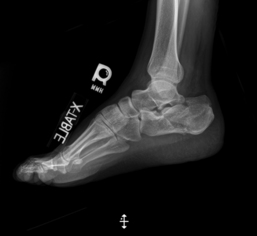
Figure 8-33. Lateral view, talar body fracture.
 Radiographs: Foot (AP/lateral/oblique) and ankle (AP/lateral/mortise). May consider Canale’s view (foot in maximum equinus, pronated 15 degrees, beam directed at 75-degree angle from horizontal plane) and Broden’s view (foot in neutral flexion with leg internally rotated 30 to 40 degrees. The beam is centered over the lateral malleolus; radiographs are taken at 40, 30, 20, and 10 degrees toward patient’s head) for further evaluation.
Radiographs: Foot (AP/lateral/oblique) and ankle (AP/lateral/mortise). May consider Canale’s view (foot in maximum equinus, pronated 15 degrees, beam directed at 75-degree angle from horizontal plane) and Broden’s view (foot in neutral flexion with leg internally rotated 30 to 40 degrees. The beam is centered over the lateral malleolus; radiographs are taken at 40, 30, 20, and 10 degrees toward patient’s head) for further evaluation.
 CT: A scan provides better fracture detail, which is useful in assessing comminution, success of reduction, and congruency of subtalar joint.
CT: A scan provides better fracture detail, which is useful in assessing comminution, success of reduction, and congruency of subtalar joint.
Classification
 Talar neck: Hawkins classification (Table 8-7)
Talar neck: Hawkins classification (Table 8-7)
Table 8-7.
Hawkins Classification of Talar Neck Fractures
Type I: Nondisplaced
Type II: Displaced with subtalar joint subluxation
Type III: Displaced with dislocation of ankle and subtalar joint
Type IV: Displaced with dislocation at talonavicular joint
Orthopaedic procedures
Procedure (fig. 8-34)
1) Place patient in supine position with the ankle relaxed
2) Palpate the anterior joint line between anterior tibial tendon and anterior border of medial malleolous.
3) Prepare the skin with a bactericidal agent at the injection site.
4) Using sterile technique, insert needle into identified joint space, aiming posterolateral. Once the needle is in the joint space, there will be reduced resistance, allowing aspiration and/or easy injection of medication.
Aftercare instructions
1) Monitor for local erythema, edema, increased pain, or systemic symptoms. Notify clinician.
2) Local anesthetic effect will wear off within a few hours, and corticosteroid will take effect within 3 to 5 days. Patients may experience steroid flare where symptoms may be worse for the first 24 to 48 hours. This can be treated with NSAIDs and ice.
3) The patient should remain in the office for 30 minutes after injection to monitor for adverse effects.
4) He or she should avoid strenuous activity for 48 hours after injection.
Plantar fasciitis injection
Procedure (fig. 8-35)
1) Place the patient in supine or lateral recumbent position on the examination table.
2) Palpate insertion of plantar fascia on the medial, plantar calcaneus.
3) Prepare the medial aspect of the plantar heel with bactericidal solution.
4) Using sterile technique, insert a 25-gauge needle perpendicular to the skin from the medial aspect directly down to midline of the foot. Aspirate to ensure needle is not in a vessel and then slowly inject medication evenly as the needle is slowly withdrawn. Use caution to avoid injecting the calcaneal fat pad.
Aftercare instructions
1) Monitor for local erythema, edema, increased pain, or systemic symptoms and notify clinician of any symptoms.
2) Local anesthesia will wear off within a few hours, and the corticosteroid will take effect within 3 to 5 days. Patients may experience steroid flare where symptoms may be worse for the first 24 to 48 hours. This can be treated with NSAIDs and ice.
3) The patient should remain in the office for 30 minutes after injection to monitor for adverse effects.
4) Avoid strenuous activity for at least 48 hours after injection.
Morton’s neuroma injection
Procedure (fig. 8-36)
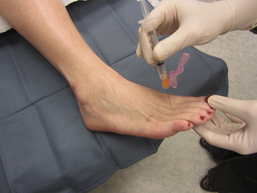
Figure 8-36. See text for the Morton neuroma injection procedure.
1) Place patient in supine position with foot in relaxed neutral position.
2) Palpate area of tenderness and mark location.
4) Insert needle on dorsal surface, pointed distal to proximal, at 45-degree angle to skin at marked site until reaching area of fullness. Be careful not to puncture through plantar skin.
Aftercare instructions
1) Patients should remain in the office for 30 minutes after injection to monitor for adverse effects.
2) Patients should avoid any strenuous activity for at least 48 hours after injection.
3) Caution patients on possible steroid flare where symptoms may be worse for the first 24 to 48 hours. This can be treated with NSAIDs and ice.
4) Call the office with any complaints of local erythema or systemic reaction.
Tarsal tunnel injection
Procedure (fig. 8-37)
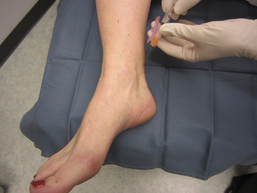
Figure 8-37. See text for the tarsal tunnel injection procedure.
1) Place patient in lateral recombinant position.
2) Percuss posterior to medial malleolus to locate area of pain, mark. Also identify PTT.
4) Insert needle, pointed distally, approximately 2 cm proximal to marked location with needle at 30-degree angle to the skin.
Aftercare instructions
1) Patients should remain in the office for 30 minutes after injection to monitor for adverse effects.
2) Patients should avoid any strenuous activity for at least 48 hours after injection.
3) Caution patients on possible steroid flare where symptoms may be worse for the first 24 to 48 hours. This can be treated with NSAIDs and ice.
4) Call the office with any complaints of local erythema or systemic reaction.

